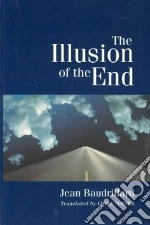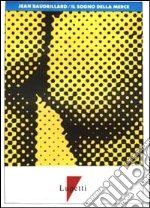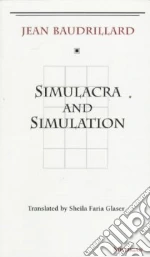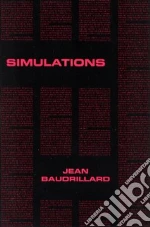 Libri di Baudrillard Jean su Unilibro.it) Libri di Baudrillard Jean su Unilibro.it)
|
|
1995 |
 Title :
The Illusion of the End
Title :
The Illusion of the EndAuthor: Baudrillard Jean, Turner Chris (TRN) Publisher: Stanford Univ Pr The year 2000, the end of the millennium: is this anything other than a mirage, the illusion of an end, like so many other imaginary endpoints which have littered the path of history? In this remarkable book Jean Baurdrillard?France's leading theorist of postmodernity?argues that the notion of the end is part of the fantasy of a linear history. Today we are not approaching the end of history but moving into reverse, into a process of systematic obliteration. We are wiping out the entire twentieth century, effacing all signs of the cold War one by one, perhaps even the signs of the First and Second World Wars and of the political and ideological revolutions of our time. In short, we are engaged in a gigantic process of historical revisionism, and we seem in a hurry to finish it before the end of the century, secretly hoping perhaps to be able to begin again from scratch. Baudrillard explores the "fatal strategies of time" which shape our ways of thinking about history and its imaginary end. Ranging from the revolutions in Eastern Europe to the Gulf War, from the transformation of nature to the hyper-reality of the media, this postmodern mediation on modernity and its aftermath will be widely read. € 22,40
|
 Title :
Il sogno della merce
Title :
Il sogno della merceAuthor: Baudrillard Jean Publisher: Lupetti Dove ci porterà questa pubblicità? Secondo l'autore si può chiamare pubblicità qualsiasi operazione che trasforma un oggetto o un'idea in uno scambio simbolico fra noi e una madre che cerca di tranquillizzare il suo bambino. La pubblicità e la "volgarizzazione" di un desiderio fusionale, la ricerca di una felicità impossibile ma vissuta magicamente come vera. Ma la pubblicità può definirsi stupida o intelligente? I propositi sono buoni solo che a giocare su questi termini di stupidità o intelligenza, oppure di buono o cattivo, secondo l'autore, ha lo stesso valore, e un modo in apparenza differente di collocarsi nel teatro delle merci. € 9,00
Scontato: € 8,55
|
|
1994 |
 Title :
Simulacra and Simulation
Title :
Simulacra and SimulationAuthor: Baudrillard Jean, Glaser Sheila Faria (TRN) Publisher: Univ of Michigan Pr The first full-length translation in English of an essential work of postmodernist thought € 19,10
|
|
|
1991 |
 Title :
Guerra virtuale e guerra reale. Riflessioni sul conflitto del Golfo
Title :
Guerra virtuale e guerra reale. Riflessioni sul conflitto del GolfoAuthor: Perniola Mario; Formenti Carlo; Baudrillard Jean Publisher: Mimesis € 8,78
Scontato: € 8,34
|
 Title :
Cool memories. Diari 1980-1990
Title :
Cool memories. Diari 1980-1990Author: Baudrillard Jean Publisher: SugarCo € 14,46
Scontato: € 13,74
|
|
1987 |
 Title :
Il sogno della merce
Title :
Il sogno della merceAuthor: Baudrillard Jean; Codeluppi V. (cur.) Publisher: Lupetti € 9,30
|
|
|
1984 |
 Title :
Le strategie fatali
Title :
Le strategie fataliAuthor: Baudrillard Jean Publisher: Feltrinelli € 10,33
|
|
|
1983 |
 Title :
Simulations
Title :
SimulationsAuthor: Jean Baudrillard Publisher: The MIT Press Ltd Simulations never existed as a book before it was "translated" into English. Actually it came from two different bookCovers written at different times by Jean Baudrillard. The first part of Simulations, and most provocative because it made a fiction of theory, was "The Procession of Simulacra." It had first been published in Simulacre et Simulations (1981). The second part, written much earlier and in a more academic mode, came from L'Echange Symbolique et la Mort (1977). It was a half-earnest, half-parodical attempt to "historicize" his own conceit by providing it with some kind of genealogy of the three orders of appearance: the Counterfeit attached to the classical period; Production for the industrial era; and Simulation, controlled by the code. It was Baudrillard's version of Foucault's Order of Things and his ironical commentary of the history of truth. The book opens on a quote from Ecclesiastes asserting flatly that "the simulacrum is true." It was certainly true in Baudrillard's book, but otherwise apocryphal.One of the most influential essays of the 20th century, Simulations was put together in 1983 in order to be published as the first little black book of Semiotext(e)'s new Foreign Agents Series. Baudrillard's bewildering thesis, a bold extrapolation on Ferdinand de Saussure's general theory of general linguistics, was in fact a clinical vision of contemporary consumer societies where signs don't refer anymore to anything except themselves. They all are generated by the matrix.In effect Baudrillard's essay (it quickly became a must to read both in the art world and in academe) was upholding the only reality there was in a world that keeps hiding the fact that it has none. Simulacrum is its own pure simulacrum and the simulacrum is true. In his celebrated analysis of Disneyland, Baudrillard demonstrates that its childish imaginary is neither true nor false, it is there to make us believe that the rest of America is real, when in fact America is a Disneyland. It is of the order of the hyper-real and of simulation. Few people at the time realized that Baudrillard's simulacrum itself wasn't a thing, but a "deterrence machine," just like Disneyland, meant to reveal the fact that the real is no longer real and illusion no longer possible. But the more impossible the illusion of reality becomes, the more impossible it is to separate true from false and the real from its artificial resurrection, the more panic-stricken the production of the real is. € 14,40
|

|

|

|